Ask a question from expert
(solved) Scientific Report
37 Pages6692 Words80 Views
Added on 2020-04-21
(solved) Scientific Report
Added on 2020-04-21
BookmarkShareRelated Documents
1
SCIENTIFIC REPORT
The Name of the Student
The Name of the Course
The Name of the Professor
The Name of the School
The City and State where it is located
Date
SCIENTIFIC REPORT
The Name of the Student
The Name of the Course
The Name of the Professor
The Name of the School
The City and State where it is located
Date
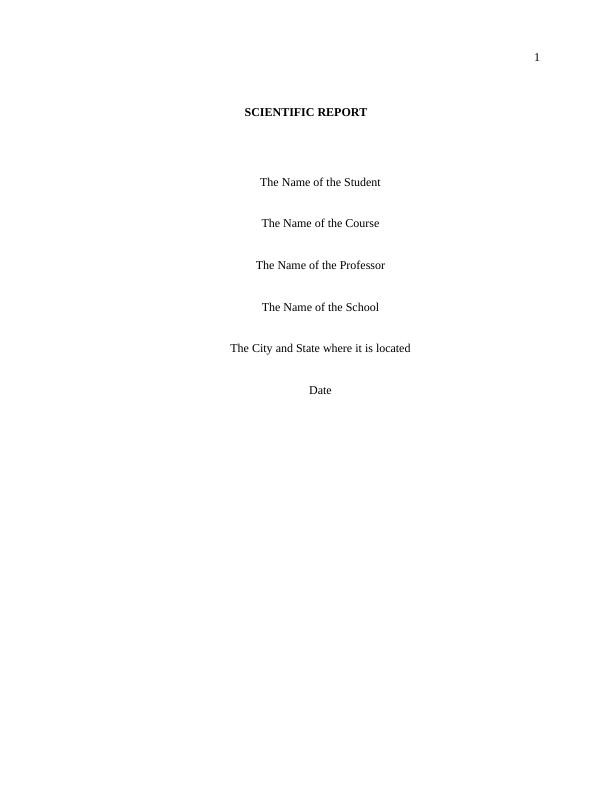
2
Abstract
Plants growth and development is the process through which plants develop new tissues
and new structures throughout their life. It is a very complicated process and is affected by
various factors. The major factors which affect plants growth and development can be broadly
classified into genetic factors and environmental factors. Genetic factors are associated to the
genes of different species of plants while environmental factors are associated to the surrounding
environment and include factors such as sunlight, CO2 concentration, water availability, soil
structure, soil aeration, and many other factors. The factors which affect the growth and
development of plants are very many and make the process to be very complex. An extensive
research by the scientists have found the growth and development process of plants to be
exponential in nature. In this scientific report, we are going to discuss the process of growth and
development of plants in details and discuss some factors which affect the process in a great
way.
Abstract
Plants growth and development is the process through which plants develop new tissues
and new structures throughout their life. It is a very complicated process and is affected by
various factors. The major factors which affect plants growth and development can be broadly
classified into genetic factors and environmental factors. Genetic factors are associated to the
genes of different species of plants while environmental factors are associated to the surrounding
environment and include factors such as sunlight, CO2 concentration, water availability, soil
structure, soil aeration, and many other factors. The factors which affect the growth and
development of plants are very many and make the process to be very complex. An extensive
research by the scientists have found the growth and development process of plants to be
exponential in nature. In this scientific report, we are going to discuss the process of growth and
development of plants in details and discuss some factors which affect the process in a great
way.
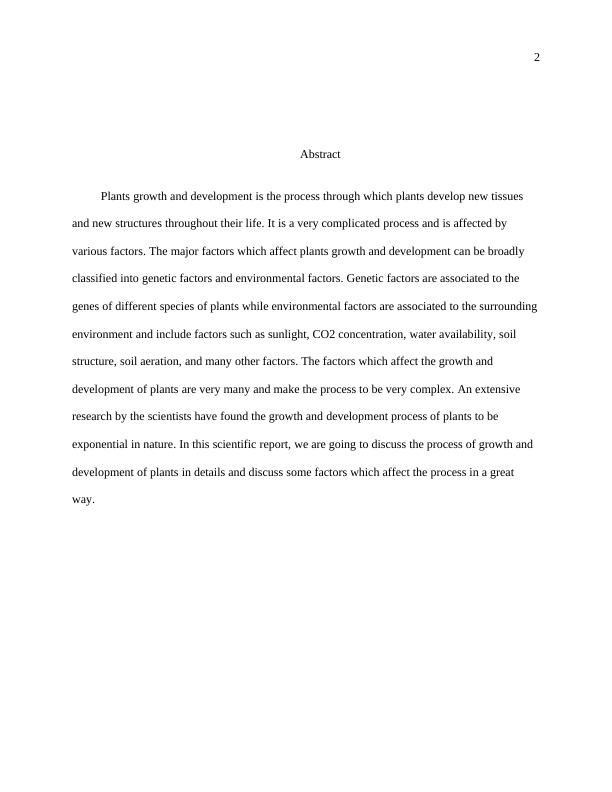
3
Table of Contents
Abstract..................................................................................................................................2
List of tables..........................................................................................................................4
List of figures........................................................................................................................5
1.0 Introduction....................................................................................................................6
2.0 Methods and materials..................................................................................................9
2.1 Objectives of the experiment.....................................................................................9
2.2 The seedling growth practical.................................................................................10
3.0 The results.....................................................................................................................11
4.0 Discussion......................................................................................................................18
4.1 A comparison of the overall plants’ masses after growing them at a CO2
concentration of 400 ppm and 700 ppm................................................................................19
4.2 A comparison of the photosynthesis rates of various plants after growing in CO2
concentrations of 400 ppm and 700 ppm...............................................................................24
4.3 A comparison of the relative growth rates of various plants after growing in
CO2 concentrations of 400 ppm and 700 ppm.......................................................................27
4.4 A summary of the discussion...................................................................................30
5.0 Conclusion.....................................................................................................................31
References...........................................................................................................................33
Table of Contents
Abstract..................................................................................................................................2
List of tables..........................................................................................................................4
List of figures........................................................................................................................5
1.0 Introduction....................................................................................................................6
2.0 Methods and materials..................................................................................................9
2.1 Objectives of the experiment.....................................................................................9
2.2 The seedling growth practical.................................................................................10
3.0 The results.....................................................................................................................11
4.0 Discussion......................................................................................................................18
4.1 A comparison of the overall plants’ masses after growing them at a CO2
concentration of 400 ppm and 700 ppm................................................................................19
4.2 A comparison of the photosynthesis rates of various plants after growing in CO2
concentrations of 400 ppm and 700 ppm...............................................................................24
4.3 A comparison of the relative growth rates of various plants after growing in
CO2 concentrations of 400 ppm and 700 ppm.......................................................................27
4.4 A summary of the discussion...................................................................................30
5.0 Conclusion.....................................................................................................................31
References...........................................................................................................................33
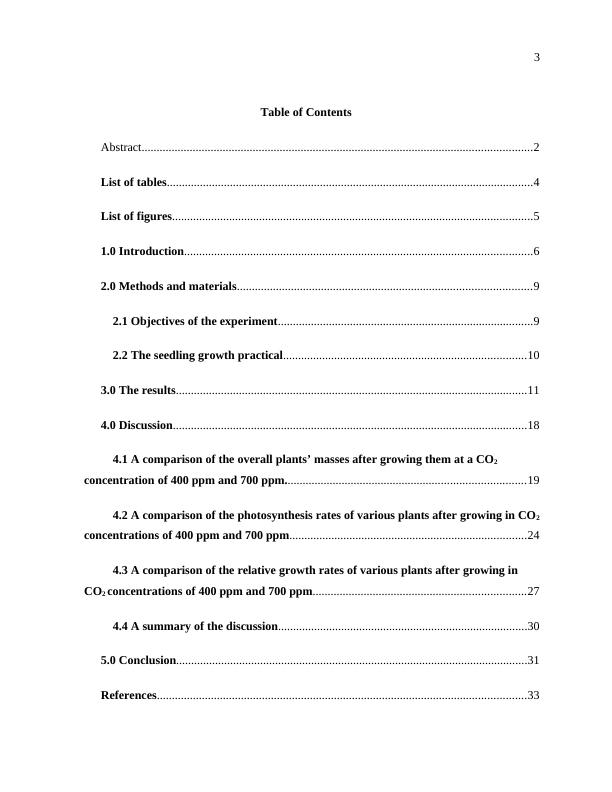
4
Appendices..........................................................................................................................36
List of tables
Table 1: A table showing the species and the families of the plants used in the experiment 9
Table 2: A table showing the initial data of the plants collected at the start of the
experiment on 15-June...................................................................................................................11
Table 3: A table showing the new masses of the plants which were grown at a CO2
concentration of 400 ppm..............................................................................................................12
Table 4: A table showing the new masses of the plants which were grown at a CO2
concentration of 700 ppm..............................................................................................................14
Table 5: A table showing the photosynthesis rate, the relative growth rate (RGR), and the
net assimilation rate at the CO2 concentration of 400 ppm...........................................................15
Table 6: A table showing the photosynthesis rate, the relative growth rate (RGR), and the
net assimilation rate at the CO2 concentration of 700 ppm...........................................................16
Table 7: A table showing the masses and total leaf area at the start of the experiment.......18
Table 8: A table showing the masses and leaf area after 5 to 7 weeks of growth in a
greenhouse with a CO2 concentration of 400 ppm.......................................................................19
Table 9: A table showing the masses and leaves’ areas after 5 to 7 weeks of growth in a
greenhouse with a CO2 concentration of 700 ppm.......................................................................20
Table 10: A table showing the photosynthesis rate, the relative growth rate (RGR), and the
net assimilation rate of various plants at the CO2 concentration of 400 ppm...............................23
Appendices..........................................................................................................................36
List of tables
Table 1: A table showing the species and the families of the plants used in the experiment 9
Table 2: A table showing the initial data of the plants collected at the start of the
experiment on 15-June...................................................................................................................11
Table 3: A table showing the new masses of the plants which were grown at a CO2
concentration of 400 ppm..............................................................................................................12
Table 4: A table showing the new masses of the plants which were grown at a CO2
concentration of 700 ppm..............................................................................................................14
Table 5: A table showing the photosynthesis rate, the relative growth rate (RGR), and the
net assimilation rate at the CO2 concentration of 400 ppm...........................................................15
Table 6: A table showing the photosynthesis rate, the relative growth rate (RGR), and the
net assimilation rate at the CO2 concentration of 700 ppm...........................................................16
Table 7: A table showing the masses and total leaf area at the start of the experiment.......18
Table 8: A table showing the masses and leaf area after 5 to 7 weeks of growth in a
greenhouse with a CO2 concentration of 400 ppm.......................................................................19
Table 9: A table showing the masses and leaves’ areas after 5 to 7 weeks of growth in a
greenhouse with a CO2 concentration of 700 ppm.......................................................................20
Table 10: A table showing the photosynthesis rate, the relative growth rate (RGR), and the
net assimilation rate of various plants at the CO2 concentration of 400 ppm...............................23
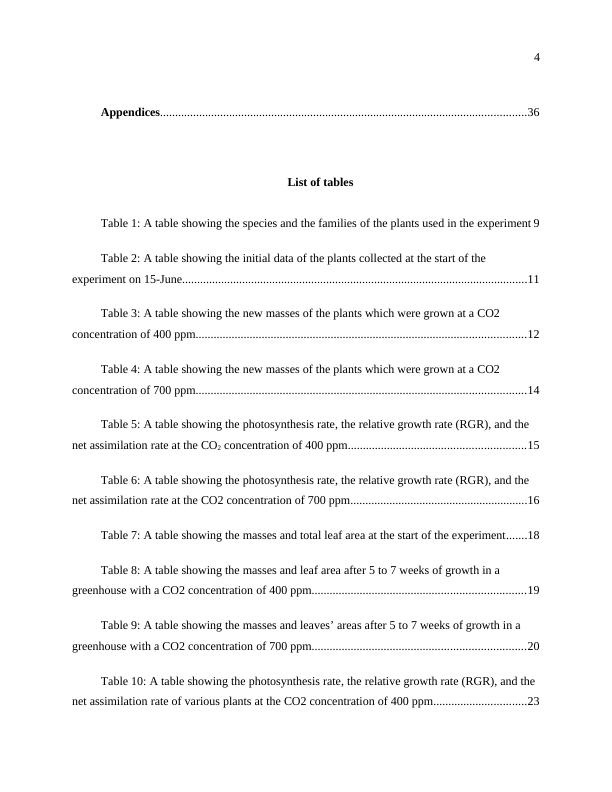
5
Table 11: A table showing the photosynthesis rate, the relative growth rate (RGR), and the
net assimilation rate of various plants at the CO2 concentration of 700 ppm...............................24
List of figures
Figure 1: Line graphs showing the comparison of the total masses of various plants after
growth in the CO2 concentration of 400 ppm and 700 ppm.........................................................22
Figure 2: Line graphs showing the comparison of the photosynthesis rates of various plants
grown at CO2 concentrations of 400 ppm and 700 ppm...............................................................26
Figure 3: A graph showing the relationship between relative rate of photosynthesis and
concentration of CO2 in ppm........................................................................................................27
Figure 4: Line graphs showing the comparison of the relative growth rates of various
plants grown at CO2 concentrations of 400 ppm and 700 ppm....................................................28
Figure 5: A figure showing typical RGR curves..................................................................29
Table 11: A table showing the photosynthesis rate, the relative growth rate (RGR), and the
net assimilation rate of various plants at the CO2 concentration of 700 ppm...............................24
List of figures
Figure 1: Line graphs showing the comparison of the total masses of various plants after
growth in the CO2 concentration of 400 ppm and 700 ppm.........................................................22
Figure 2: Line graphs showing the comparison of the photosynthesis rates of various plants
grown at CO2 concentrations of 400 ppm and 700 ppm...............................................................26
Figure 3: A graph showing the relationship between relative rate of photosynthesis and
concentration of CO2 in ppm........................................................................................................27
Figure 4: Line graphs showing the comparison of the relative growth rates of various
plants grown at CO2 concentrations of 400 ppm and 700 ppm....................................................28
Figure 5: A figure showing typical RGR curves..................................................................29
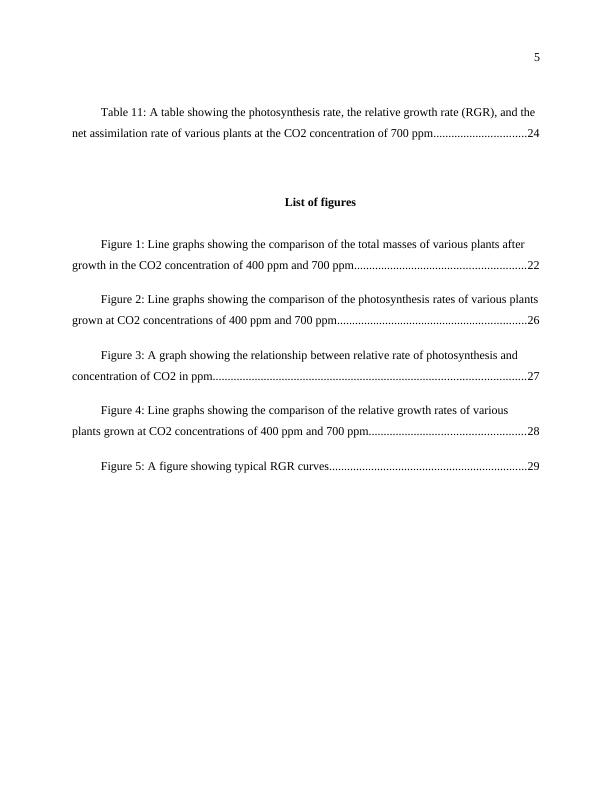
6
1.0 Introduction
In plant anatomy and physiology, plant growth and development is the process by which
the plants develop new tissues and new structures from the meristems which are located at the
tips of the plants’ organs or between the fully developed tissues of the plants. The growth
process occurs throughout the whole life of the plants (Hunt, 2012). Plant growth and
development involves various stages which the plant undergoes in its entire life. The main stages
are:
Cellular differentiation, morphogenesis, and plant embryogenesis. This is the first stage in
the life cycle of a plant. A plant begins to form after the fertilization of the egg cell and the
sperm cell. After the process of fertilization, the division process starts which leads to the
formation of the plant embryo through the process of embryogenesis. The process of
embryogenesis leads to the formation of a complex cell which forms a root on one end while the
other end forms the shoot. At the end of the embryogenesis process, the plant will have all the
necessary parts which are needed for the life of the plant to start. Once the plant starts to shoot, it
will develop the other organs (roots, stems, and leaves) through organogenesis process (Sanchez,
Biancardi, and Goes, 2014, pp.458-466).
Morphological variation stage. This is the stage in the growth and development of the
plants where different plants exhibit some natural variations in their forms and structures. The
variations are openly witnessed on the leaves of the plants. The stems and the roots also undergo
some variations, although in some plants it may be difficult to see the variations.
1.0 Introduction
In plant anatomy and physiology, plant growth and development is the process by which
the plants develop new tissues and new structures from the meristems which are located at the
tips of the plants’ organs or between the fully developed tissues of the plants. The growth
process occurs throughout the whole life of the plants (Hunt, 2012). Plant growth and
development involves various stages which the plant undergoes in its entire life. The main stages
are:
Cellular differentiation, morphogenesis, and plant embryogenesis. This is the first stage in
the life cycle of a plant. A plant begins to form after the fertilization of the egg cell and the
sperm cell. After the process of fertilization, the division process starts which leads to the
formation of the plant embryo through the process of embryogenesis. The process of
embryogenesis leads to the formation of a complex cell which forms a root on one end while the
other end forms the shoot. At the end of the embryogenesis process, the plant will have all the
necessary parts which are needed for the life of the plant to start. Once the plant starts to shoot, it
will develop the other organs (roots, stems, and leaves) through organogenesis process (Sanchez,
Biancardi, and Goes, 2014, pp.458-466).
Morphological variation stage. This is the stage in the growth and development of the
plants where different plants exhibit some natural variations in their forms and structures. The
variations are openly witnessed on the leaves of the plants. The stems and the roots also undergo
some variations, although in some plants it may be difficult to see the variations.

7
Leaf development stage. This is the stage where the plant starts massive development of
leaves and branches. The plants develop leaves of different shapes and sizes depending on the
type of the plant. The leaves are very important in plants as they are the major organs of
photosynthesis (Dubey, Dwivedi, and Lahtinen, 2013, pp.134-142)
Flower development stage. In this stage, the plants develop the flowers used for the
reproduction process. The flowers contain the male and the female reproductive organs of the
plants, and therefore, help in the reproduction process. In some plants, the male and the female
reproductive organs are found in the same flower while other plants have them separate in
different plants (Takhtajan, 2009).
Fruits development stage. This is the stage where the plant produces some fruits and comes
after the flowering stage. All the flowering plants produce fruits. However, it is important to note
not all the plants produce some fruits as we have some non-flowering plants which produce
spores or seeds instead of fruits (Pang, Luo, and Sun, 2012, pp.839-844).
Having discussed the process of growth and development in plants, it is important to
discuss some factors which affect the process of growth and development in plants. The major
factors which affect the growth and the development of plants can be broadly classified into the
genetic factors and the environmental factors.
The genetic factors are determined by the genes of different plants. The genes play an
important role in the growth and development of the plants. The natural genes have been
Leaf development stage. This is the stage where the plant starts massive development of
leaves and branches. The plants develop leaves of different shapes and sizes depending on the
type of the plant. The leaves are very important in plants as they are the major organs of
photosynthesis (Dubey, Dwivedi, and Lahtinen, 2013, pp.134-142)
Flower development stage. In this stage, the plants develop the flowers used for the
reproduction process. The flowers contain the male and the female reproductive organs of the
plants, and therefore, help in the reproduction process. In some plants, the male and the female
reproductive organs are found in the same flower while other plants have them separate in
different plants (Takhtajan, 2009).
Fruits development stage. This is the stage where the plant produces some fruits and comes
after the flowering stage. All the flowering plants produce fruits. However, it is important to note
not all the plants produce some fruits as we have some non-flowering plants which produce
spores or seeds instead of fruits (Pang, Luo, and Sun, 2012, pp.839-844).
Having discussed the process of growth and development in plants, it is important to
discuss some factors which affect the process of growth and development in plants. The major
factors which affect the growth and the development of plants can be broadly classified into the
genetic factors and the environmental factors.
The genetic factors are determined by the genes of different plants. The genes play an
important role in the growth and development of the plants. The natural genes have been
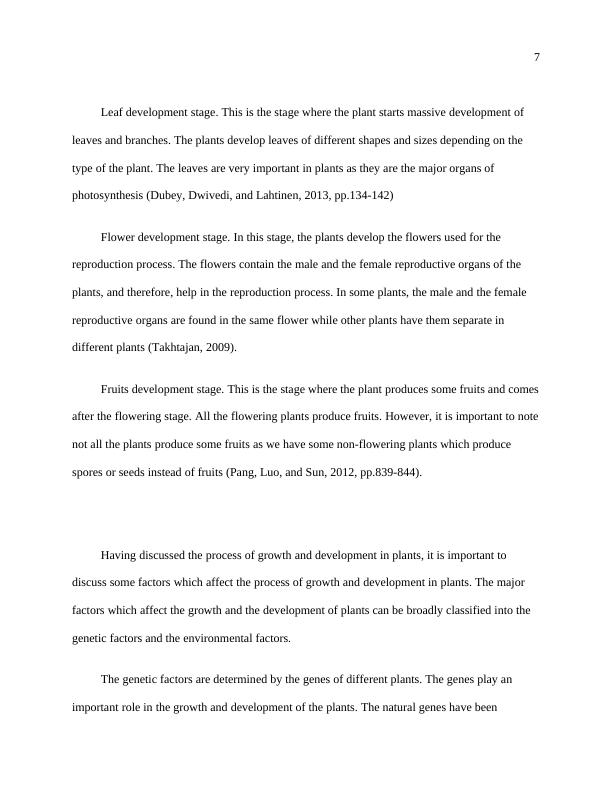
8
combined with some artificial genes improve the performance of some crops. The resulting
hybrid crops have higher yields and have some improved traits as compared to the natural plants.
Some of the desirable traits which can be observed in hybrid crops include good quality, higher
resistance to different diseases, and great tolerance to dry conditions (Mallet, 2007, pp.279-283).
The environmental factors also affect the growth and the development of plants in a great
way. The environmental factors are the external conditions in the environment which affect the
growth of plants. Some of the major environmental factors which affect the growth of plants
include the temperature of the region, carbon (iv) oxide (CO2) concentration, the moisture
supply, the radiant energy, the soil structure, and aeration. The atmosphere composition, the
biotic factors, the supply of the required nutrients from the soil, and existence or absence of some
growth restricting substances also affect the growth of plants (Kramer and Kozlowski, 2012).
In this scientific report, we are going to discuss some factors which affect the growth rate
of plants. We shall do a detailed analysis to examine how these factors affect the relative growth
rate (RGR) of different plants. Relative growth rate is the rate of mass growth per unit mass
which is already present. Relative growth rate is one of the major measures which are used to
determine the growth potentials of different plants. The RGR is considered valid when the
conditions of light, nutrients, and water are kept constants in all the plants under consideration
(Rees, Osborne, and Turnbull, 2010). We shall use ten different native species, and each species
will be represented by ten different seedlings. The results which we shall obtain will help us to
come up with a comprehensive conclusion on some factors which affect the growth and
development of plants and how they affect it.
combined with some artificial genes improve the performance of some crops. The resulting
hybrid crops have higher yields and have some improved traits as compared to the natural plants.
Some of the desirable traits which can be observed in hybrid crops include good quality, higher
resistance to different diseases, and great tolerance to dry conditions (Mallet, 2007, pp.279-283).
The environmental factors also affect the growth and the development of plants in a great
way. The environmental factors are the external conditions in the environment which affect the
growth of plants. Some of the major environmental factors which affect the growth of plants
include the temperature of the region, carbon (iv) oxide (CO2) concentration, the moisture
supply, the radiant energy, the soil structure, and aeration. The atmosphere composition, the
biotic factors, the supply of the required nutrients from the soil, and existence or absence of some
growth restricting substances also affect the growth of plants (Kramer and Kozlowski, 2012).
In this scientific report, we are going to discuss some factors which affect the growth rate
of plants. We shall do a detailed analysis to examine how these factors affect the relative growth
rate (RGR) of different plants. Relative growth rate is the rate of mass growth per unit mass
which is already present. Relative growth rate is one of the major measures which are used to
determine the growth potentials of different plants. The RGR is considered valid when the
conditions of light, nutrients, and water are kept constants in all the plants under consideration
(Rees, Osborne, and Turnbull, 2010). We shall use ten different native species, and each species
will be represented by ten different seedlings. The results which we shall obtain will help us to
come up with a comprehensive conclusion on some factors which affect the growth and
development of plants and how they affect it.
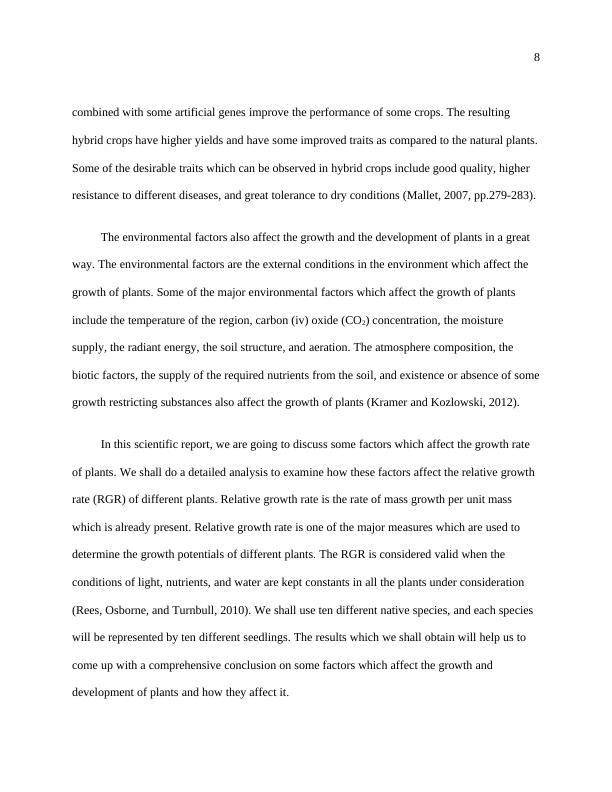
End of preview
Want to access all the pages? Upload your documents or become a member.
Related Documents
Factors Affecting Transpiration in Plantslg...
|9
|1447
|89
Seed Germination Experimentlg...
|9
|1854
|13